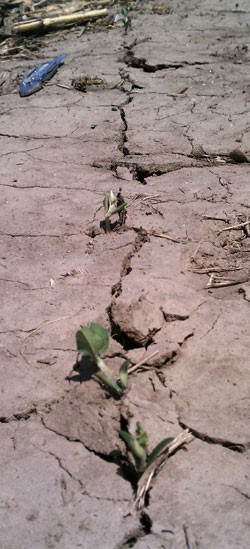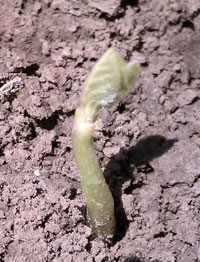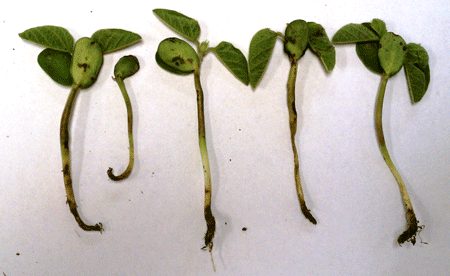
May 21, 2019, 9:30 PM
Planting Soybeans
Everyone is eager to be out in the fields and planting this time of year. However, unseasonably cold temperatures and wet conditions have been the theme for much of our area. When we think about planting soybeans, this is one crop that we should probably consider waiting to plant until conditions are more favorable.
Factors to Consider
Here are some key factors to consider for successful soybean planting:
- Soil temperature: The ideal soil temperature for soybean germination and emergence is 77°F at a 2” soil depth. Typically, our soils don’t reach that temperature until late May or early June. Soybeans can germinate at soil temperatures of 50°F at 2” soil depth, but emergence is slow and could take up to 3 weeks at these lower temperatures.
 Figure 1. Uneven soybean emergence in crusted soil in south central Nebraska
Figure 1. Uneven soybean emergence in crusted soil in south central Nebraska
- Weather conditions: If possible, avoid planting when the upcoming forecast is calling for extreme cold and wet weather. Planting in cool and wet soils is never a good idea. Saturated soils and the formation of a soil crust can cause poor emergence.
Figure 2. Plumule emerging from soybean stem where cotyledon was snapped off below ground.
- Soil Conditions: Cool and wet conditions not only lead to poor germination but can lead to an increase in seedling diseases. Cold, wet soils slow root development and make the seedlings more susceptible to root rotting diseases. Pythium, rhizoctonia, fusarium and phytophthora root rot all like wet conditions while Pythium also likes cold soils.

Figure 3. Cold snap and seedling disease pathogens cause lesions on roots and cotyledons of soybeans. (Photo by Jennifer Rees)
Action Plan
It is important to get your soybean crop off to a good start.
- Avoid “mudding-in” your soybeans. Putting them into soil that is too wet can increase your risk of seedling mortality and reduced emergence.
- Crusting can kill your soybeans. As the soybeans push their cotyledons out of the ground, the cotyledons can be damaged by the soil crusting and can even break off.
- Adjust your seeding rate and depth for the actual planting conditions. If conditions are wet, you should consider more shallow seed placement and an increased seeding rate to allow for more mortality.
- If there is a history of these seedling diseases, a fungicide seed treatment is recommended. We recommend using Legend Seeds YP Pro+ Soybean Treatment.
Summary
The important thing to consider when planting soybeans is to plant into a good seedbed. The risks of planting in unfavorable conditions are greater than the potential rewards. Be patient and resist the temptation to plant into unfavorable soil conditions. It is critical that soil conditions are favorable before planting.

